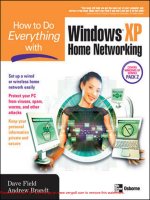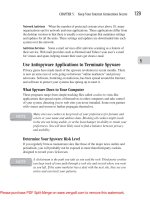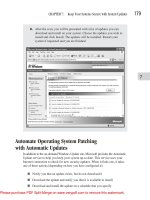Tài liệu How To Do Everything With Windows XP Home Networking- P2 ppt
Bạn đang xem bản rút gọn của tài liệu. Xem và tải ngay bản đầy đủ của tài liệu tại đây (2.36 MB, 50 trang )
Ethernet over Telephone Lines
Several manufacturers also sell devices to carry Ethernet over standard phone lines.
These devices currently support data rates of 10 Mbps.
Ill 1-15
CHAPTER 1: Learn about Home Networks
29
1
Please purchase PDF Split-Merge on www.verypdf.com to remove this watermark.
This page intentionally left blank
Please purchase PDF Split-Merge on www.verypdf.com to remove this watermark.
Chapter 2
Design Your Own
Home Network
Copyright © 2004 by McGraw-Hill Companies. Click here for terms of use.
Please purchase PDF Split-Merge on www.verypdf.com to remove this watermark.
32
How to Do Everything with Windows XP Home Networking
How to…
■
Determine your requirements
■
Choose between wired and wireless
■
Map your physical network
■
Map your logical network
■
Create a utilization plan
Y
ou’ve read up on the basics of home networking, and now you’re no doubt
itching to roll up your sleeves and get started putting in the system. In this
chapter we will cover the planning of your network and the selection of appropriate
equipment for your design.
Mostly what you are going to need are a basic idea of your requirements for your
network and a plan of how we are going to satisfy those requirements. We start by
creating a list of all the devices you are planning to place on the network. We will
determine the best way to connect them and which type of network device to use
for the task. We will then map it all out so that you can refer to the plan later when
you are installing your network equipment.
Determine Your Requirements
The first thing you need to do is make a list of all the items you are planning to connect
to the network. This list is not as short these days as it once was. In addition to a list
of your computers and possibly a printer or two, you can now add your home media
equipment, cameras for viewing the front door or back yard, the game console, and
even network devices such as storage drives or IP telephones. Some of these devices
will include their own network connections; some will need optional networking
devices to enable them to connect to the network. Take a look at your documentation
on the device to see if it includes an Ethernet port or if it supports TCP/IP networking.
List Your Computers
The first devices to list are your computers. They were the first residents of networks
and will continue to be the main network devices for some time yet. Create a simple
list of computers by name of computer. This list can be done on your computer and
Please purchase PDF Split-Merge on www.verypdf.com to remove this watermark.
CHAPTER 2: Design Your Own Home Network
33
2
printed for ready reference, or it can be kept on note paper if your computer is still in
a box. In most cases this will be the computer name that is configured in Windows XP.
Figure 2-1 shows the Windows XP System Properties dialog box with the Computer
Name tab displayed. If you have not named your computers yet, you can do so now
or use a description instead.
Network Attached Storage
If you require centralized storage for media or document files, you can attach
a Network Attached Storage (NAS) device to the network. A NAS unit is simply
a server optimized for file sharing. It can have one or more disk drives, providing
gigabytes of storage space, and can typically be accessed by most operating
systems and web browsers on the network.
FIGURE 2-1
Computer name displayed in System Properties dialog box
Please purchase PDF Split-Merge on www.verypdf.com to remove this watermark.
34
How to Do Everything with Windows XP Home Networking
List each computer name, the operating system version it is running, whether it
will be sharing any printers or files, and what type network adapter it has installed
(if any). This information will be used when mapping the network and will also
help determine if any additional hardware will be required to connect the computer
to the network. An excerpt from the author’s device list appears in Figure 2-2.
Change the Name of Your Computer
If you still have the default computer name given to you by Windows, usually
something that looks like YOUR12E2341, now would be a good time to give
your computer a descriptive name:
1.
Right-click My Computer and select Properties, or open the System
applet in the Control Panel.
2.
Select the Computer Name tab; click Change to open the Computer
Name Changes dialog box.
Ill 2-1
3.
Enter a new computer name in the Computer Name field and click OK.
4.
You will be prompted to restart your computer to complete the name
change. Click OK to restart your computer.
Please purchase PDF Split-Merge on www.verypdf.com to remove this watermark.
CHAPTER 2: Design Your Own Home Network
35
2
There may be additional pertinent information about the devices you are listing.
Recording this information will be helpful when you are determining how best to
construct your network. This may be information such as
■ The brand of your Ethernet adapter (if known).
■ Any special notes about the device’s location in the house, such as wireless
signal obstructions.
■
Any special cabling concerns, such as having solid walls, and any need for
surface-mounted cable raceways.
List Your Other Network Devices
There may be other devices you are planning to connect to your network. An example
of an additional device would be your Game Cube or a network camera. Add these
devices to the list as well, keeping in mind that you will need to know where and how
they will connect to the network.
Plan for Future Expansions
As more network-enabled devices become available, it will be necessary to extend
network connections to them as well. Most new network-enabled consumer devices
FIGURE 2-2
The Author’s network device list
Please purchase PDF Split-Merge on www.verypdf.com to remove this watermark.
use wireless Ethernet to enable connectivity. This will make it simpler to get these
devices added, but it makes wireless networking a must if you want to future-proof
your network. If you plan to include any of these kinds of devices in your network
in the future, you will want to plan now for installing wireless Ethernet.
For more information on next-generation wireless devices, see the spotlight
section in the center of the book.
Select the Best Network Type for Your Home
There are many factors that can work for or against a certain network technology.
■
Accessibility to crawl spaces or attics can dictate whether it is possible to
get cables from room to room.
■ Building materials used in walls, floors, and ceilings may help determine
whether radio signals can pass through them without excessive signal loss.
■ Security concerns or ease of installation may tip the scale in one direction
or the other.
■ Speed may be a factor if you regularly transfer large media files from computer
to computer or between your computer and your media equipment.
In this section we will present some of these concerns and help you decide which
technology is best for your home.
Planning Cable Routes
For wired Ethernet installations, it is necessary to get the cable from one room to
another. There are many ways to accomplish this, and each will have to be evaluated
to determine whether this type of network is feasible. The effect on the appearance
of the home will also be a factor. Many of us will want to hide cables in walls, in
floors, or above the ceiling.
Chapter 3 will discuss many ways of getting cables into hard-to-reach places.
We will discuss room-to-room cable routing techniques, ways to get cable around
a room, and other tricks of the trade. Keep in mind as you read the tricks that extreme
measures will be necessary only if you cannot find an effective alternative. Wireless
Ethernet should be considered before you go tearing up your house unless you have
a security need that prevents your considering it.
36
How to Do Everything with Windows XP Home Networking
Please purchase PDF Split-Merge on www.verypdf.com to remove this watermark.
Why Building Materials Matter
Building materials matter just as much in your determination of which technology
to use as the construction method the builder used. Certain materials can block the
radio signals of wireless Ethernet. Other materials will make it very difficult to get
cable where you need it.
Signal Attenuation by Metallic Materials
Signal attenuation is the capacity of certain types of building materials to weaken
or block radio signals. Materials such as reinforced concrete, aluminum siding,
metallic screens, and expanded metal lath can effectively block radio signals in the
2.4 GHz band—the frequency band used by 802.11b and 802.11g wireless Ethernet.
Reinforced concrete and metal studs are used extensively in commercial buildings,
apartments, and condominiums. Metal lath is used to reinforce plaster walls. If you
suspect your home includes these materials, or any other material with a high metallic
content, you may want to have a couple of wireless-equipped laptop-toting friends
come over and test your walls.
Think of the radio signal as a powerful flashlight beam that can shine
through only a certain amount of material. The more dense the material,
the less the beam will penetrate. Shine the beam around your place,
focusing it on where the radio signal will need to go. What do you see
between you and your target? Is there a concrete floor? A paneled wall?
If you visualize your installation in this way, you will begin to see where
you will have attenuation problems.
The alternative, of course, to wireless in these circumstances would be wired
Ethernet. Buildings using concrete and steel construction should have conduits and
plenum spaces you might use to route your cables. Check with the building
maintenance manager to see if there are any open conduits you can use. If you own
your home, you may need to hire an electrician to locate or install conduits or cable
raceways.
Fiberglass Makes You Itchy
Not to be ruled out in your evaluation of which method to use is the fact that you
may have to crawl across carpets of fiberglass insulation or try to push cables through
insulated wall spaces. Building materials like brick and adobe are definitely going
to resist your efforts to run cable. In these environments you may have to opt for
cable raceways or other surface-mount techniques.
CHAPTER 2: Design Your Own Home Network
37
2
Please purchase PDF Split-Merge on www.verypdf.com to remove this watermark.
Unfortunately, some of these materials will attenuate wireless signals as well,
so test your area before you invest too much in wireless technology.
Security Implications for Network Selection
In environments where security is a top concern, wireless Ethernet is sometimes
shunned by network installers. At the end of the day, you are the one that has to
rest easy knowing your data is secure. Wired Ethernet is definitely simpler to secure,
as you know with certainty where is comes from and where it goes. You won’t have
to take extra measures to ensure your data is secure on the network. However, as you
will see in Chapter 6, there are excellent ways to secure wireless networks against
all but the best-equipped crackers.
Distance Criteria in Network Selection
As you begin to plan for your installation, you will begin to see how far your devices
are from your hub or router. Most homes will not pose a problem for distance, but
it may be wise to keep in mind the effective distances of each network technology.
Table 2-1 shows the transmission distances each common home network technology
can achieve. Keep in mind these are for best-case scenarios. Signal attenuation will
shorten your effective distance for wireless Ethernet. Cable defects can shorten your
effective distance for wired Ethernet.
When You Feel the Need for Speed
The last aspect of network requirements we will consider in this section is speed.
Some applications simply require more bandwidth than certain technologies are
capable of. At 54 Mbps, 802.11g wireless Ethernet has largely closed the gap with
38
How to Do Everything with Windows XP Home Networking
Network Technology Maximum Distance
1
Maximum Speed
2
Category 5 Wired Ethernet 328 feet (100 meters) 100 Mbps
802.11a Wireless Ethernet 50–75 feet 54 Mbps
802.11b Wireless Ethernet 300 feet 11 Mbps
802.11g Wireless Ethernet 250 feet 54 Mbps
1
Wireless network technologies are rated under perfect conditions. Real-world installations will have attenuation factors and radio
frequency interference that will shorten the effective distance you can achieve.
2
Speed for wireless technologies will decrease as distance approaches maximum. At a maximum distance, it is not uncommon to see
speeds as low as 1 Mbps.
TABLE 2-1
Distances for Various Network Types
Please purchase PDF Split-Merge on www.verypdf.com to remove this watermark.
100 Mbps wired Ethernet. In fact, some wireless vendors are making 108 Mbps
wireless available with proprietary channel-bonding technologies.
Channel bonding leads to incompatibility problems. For more information,
see the Did You Know? sidebar about channel bonding in Chapter 6.
Most of the consumer wireless gear, such as cameras and media-sharing devices,
uses 11 Mbps 802.11b wireless Ethernet for connectivity. If the device is designed
for that speed, it will likely be effective for your needs. Keep in mind that wireless
bandwidth is aggregate. This means that each device transmitting at 11 Mbps is
using the full resources of your network’s access point or router when it is transmitting.
When additional devices come on the air, the bandwidth available for all is reduced
proportionately. If wireless is still your first choice, using 802.11g access points
and routers would be a good choice for this scenario. These devices are downward-
compatible with 802.11b and will have speed to spare for other devices.
Create a Physical Map of Your Network
To be able to visualize your network, you need to lay it all out on a map. The technique
you use is less important than the planning a map will require. You may not be the
type who writes things down, preferring to get out the tools and start pulling cable.
I urge you to persevere with this step. It will aid you in estimating your materials,
it will point out potential problems you will face, and it may be necessary if your
municipality requires prints for any work of this type. Figure 2-3 shows the plan of
a home’s first floor. You will see this plan again as we discuss other topics in this
section.
CHAPTER 2: Design Your Own Home Network
39
2
High-Speed Ethernet
If you find 100 Mbps is not enough (you’re designing space shuttles or
broadcasting High Definition Video), you may need to investigate higher-speed
technologies such as wired Gigabit Ethernet or even 10 Gigabit Ethernet. These
technologies are still too expensive for most homeowners and are used only in
corporate backbone networks and on high-performance servers and workstations.
If you see yourself needing this kind of horsepower, you will probably require
the assistance of a professional installer, as your cable runs need to be certified
to Cat5E or Cat6 to support these speeds.
Please purchase PDF Split-Merge on www.verypdf.com to remove this watermark.
Sketch the Outline
For visual appeal, we use computer-generated drawings in our book. You have no
such restrictions. If you are comfortable drawing this on the back of an envelope,
by all means, go ahead. Be sure to measure and indicate the relative positions of
walls and rooms. You will be referring to this plan, as shown in Figure 2-4, when
you determine your placement of equipment. Know where your network devices
will be placed. If your home will have equipment on two levels, sketch both levels
and indicate the relationship between the two. If you will be submitting this to
a building official, they will want to know where you will be creating openings
between floors.
Add Your Devices to the Map
After you have the general outline of your rooms, you can begin to place your network
devices on the map. As you do this, you will begin to see where your networking
40
How to Do Everything with Windows XP Home Networking
FIGURE 2-3
First floor plan of a home
Please purchase PDF Split-Merge on www.verypdf.com to remove this watermark.
challenges will be. In the house in these drawings, you can see challenges both for
pulling cables and for wireless coverage. Both levels are fully finished, so pulling
cable would require special tools such as special drills and fish tapes (metal or
fiberglass coils that can be “fished” inside a wall to guide a cable). There is also
a mass of closets and stairs in the center of the first floor. This will attenuate the
wireless signal quite a bit. Only by placing our devices on the map will we see
these challenges and be able to develop strategies for dealing with them. Figure 2-5
shows the plan with placement of potential network devices.
As you can see, this installation calls for some flexibility for movement for a laptop
computer. You can see that wireless Ethernet will play some role in this design unless
we give the poor soul a 100-foot cord!
CHAPTER 2: Design Your Own Home Network
41
2
FIGURE 2-4
The multi-level floor plan
Please purchase PDF Split-Merge on www.verypdf.com to remove this watermark.
42
How to Do Everything with Windows XP Home Networking
Get the Numbers Right
A network map will help you think in terms of distance. You will come to know
how many feet your cable has to reach; how many walls your signal must penetrate.
You will begin to see relationships between different network devices. You may
discover that, for instance, if you move your desk you can take advantage of a wall
shared with your media center in the next room.
Take measurements of all your potential cable routes. Keep in mind both the
amount of rise (vertical distance) and run (horizontal distance) the cable will have
FIGURE 2-5
Placing network devices
Please purchase PDF Split-Merge on www.verypdf.com to remove this watermark.
CHAPTER 2: Design Your Own Home Network
43
2
to travel. The total of the two will be the required length for your cable. When you
are done, you can add up all your cable lengths to determine how much cable you
will require overall.
Visualize Your Signal
If your plan begins to get a bit too ambitious for wired installation (as ours has), you
will probably start to determine how to get the best wireless Ethernet signal to
your network devices.
Many people set up a wireless access point in the home office, put wireless
adapters in each computer, and wonder why they are only getting 2.5 Mbps in the
next room. When you are looking at your plan, try to spot signal blockers. These
can be plasterboard walls, concrete floors, large plants, even closets full of outdoor
wear.
Microwaves Are Used
to Transmit Data
The ability of water molecules to capture microwaves is what makes a microwave
oven work. The microwaves are captured by the water molecules in food and
transfer their energy to the food. This is why you will be able to remove a glass
plate without a hot pad after cooking. The heat was transferred only to the water-
containing food. Microwave a dry pretzel sometime. It will barely get warm.
But put a moist slice of bread in for a few seconds and it will burn your hand.
Wireless Ethernet uses microwaves to transmit data. Any item in your house
that contains water will effectively block these radio waves. This can be a large
plant, a closet of wet coats, a laundry basket, even your family members. After
all, we are just large bags of water as far as radio waves are concerned!
Commercial installers of wireless Ethernet equipment will tell you that they
have to plan for crowds when they install equipment. They will either raise the
antennas above the crowd or plan for reduced range when the room fills up.
Please purchase PDF Split-Merge on www.verypdf.com to remove this watermark.
Look closely at the Home Office in Figure 2-5. Right next door is the laundry.
This room will contain damp clothing, large electromagnetic fields from the
appliances, water pipes, and a closet for wet coats and boots. Aside from metal,
water is probably the best most effective attenuator of microwaves.
If I were to install a wireless access point or router in the Home Office, I would
run the risk of intermittent signal loss. In addition, I would always have difficulty
reaching the kitchen through what amounts to six or seven walls.
Where else can I put it? Take a look up on the second floor. That is where the
Writing Office is. It seems sort of off to one side, but we can play a neat trick here.
If I send a Cat5 cable up the inside wall, I can run it a short distance through the
attic to the center of the house, as shown in Figure 2-6. Installing a wireless access
point there will shower signals down through the entire house from above. At most,
each room will be getting its signal through a carpeted floor and one wall. Centering
the access point will also shorten the distance any signal would have to travel.
Being flexible in your placement will help you get the best coverage possible.
44
How to Do Everything with Windows XP Home Networking
FIGURE 2-6
Centering the wireless access point
Please purchase PDF Split-Merge on www.verypdf.com to remove this watermark.
CHAPTER 2: Design Your Own Home Network
45
2
Create a Logical Map of Your Network
A map of your physical layout and network device placement is intended to help
you visualize the scope of your wired or wireless installation. A physical map will
deal with actual device placement and cabling, while a logical map will assist you
with the setup and configuration of your devices once they have been connected to
the network.
Once again, it is not necessary to create a piece of art suitable for framing here.
You mainly need a good idea of how the various devices are connected to the network
and, by extension, to each other. You also need a way to keep a record of their
addresses or other configuration information. An ink sketch of the devices and
their connections to each other is sufficient. You can fill in the addresses when you
have assigned them.
Determine the Placement of Concentrators
When you have determined which type of network you are going to install, you will
place the appropriate concentrators (hubs or switches) at the center of your network.
Since this is merely a logical map, it is sufficient to arrange your devices in
Install Antennas to Remote
Locations
You can install wireless networking equipment in places not served by power
lines by transmitting the power over the Cat5 Ethernet cable. Power over
Ethernet devices are produced by most manufacturers of wireless networking
devices and are available from online retailers and select local computer stores.
A special device connects to one end of the run and injects electrical current
into the same cable that carries your network signal. Another connector on the
other end pulls the power off the cable and makes it available to power the network
device.
If you find it impossible to route your network cable and power to a remote
location, you can also purchase extension cables and remote antennas for your
access point. These allow you to place the antenna a short distance away from
your wireless device to get better placement.
Please purchase PDF Split-Merge on www.verypdf.com to remove this watermark.
a semicircle around your concentrator. As you develop the logical design, you will
fine-tune the placement of your physical devices.
The concentrator will form the focal point of your network. Each device will
connect directly to the concentrator, either with cable or via wireless connection.
Figure 2-7 shows the network we are designing using wireless Ethernet.
For wired networks, you will need to provide “home runs” for your devices to
the central switch or hub. A home run is an unbroken length of cable from a device
or its wall plate to the main wiring location. As you begin to see the requirements
for cable runs, you may decide to adjust the placement of your concentrator in the
home. It does not need to be in the office; it can even be in a closet if that is the
most efficient place for it. Feel free to move back and forth between your physical
map and your logical map as you see the need to make adjustments.
Figure 2-8 shows our devices connected by cables. Note the laptop and
televisions are still using wireless. In this situation, it would be better to choose
a hybrid of wired and wireless connectivity, as the laptop would lose its mobility
with cabled Ethernet and the media-sharing devices are designed specifically for
wireless Ethernet.
46
How to Do Everything with Windows XP Home Networking
FIGURE 2-7
A diagram of our devices using wireless networking technology
Please purchase PDF Split-Merge on www.verypdf.com to remove this watermark.
Create a Network Utilization Plan
By now, we have placed all of our equipment except for the cable/DSL modem.
The concentrator (router or gateway in this case) or its antenna is planned for the
upstairs hallway, each device has its physical location mapped, and we know how
we plan to extend connectivity to it. For the actual execution of the cabling plan, we
will refer to Chapter 3 for wired Ethernet or Chapter 4 for wireless Ethernet. All that
remains for now is to decide how these devices will interact. Do we want kids to
store their homework on the Home Office computer? Will any of the PCs be tapping
into the media sharing network? Will all computers have Internet access?
As we answer these questions, we will be forming our plan for implementation
of the peer-to-peer networking features of Windows XP, and for control of the Internet
access settings of the Internet Gateway. When we cover installation of networking
features in the next two chapters, we will cover basic setup of these services.
CHAPTER 2: Design Your Own Home Network
47
2
FIGURE 2-8
The same network devices using wired Ethernet
Please purchase PDF Split-Merge on www.verypdf.com to remove this watermark.
48
How to Do Everything with Windows XP Home Networking
Most Homes Use
Peer-to-Peer Networks
Most home networks will employ a peer-to-peer or workgroup logical
configuration. This type of network allows each computer to control access
to its own files and printers. Each computer controls security for its own
resources, and there is no central administration.
This is opposite to what you will see in most corporate networks. These
larger networks will employ centralized access controls and will be controlled
by a central administrator. Networks of this type are known as domain or
directory networks.
Please purchase PDF Split-Merge on www.verypdf.com to remove this watermark.









